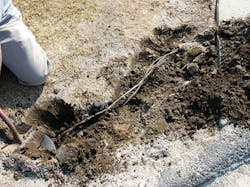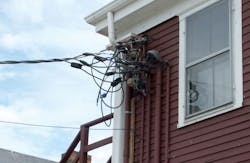How well do you know the Code? Think you can spot violations the original installer either ignored or couldn't identify? Here's your chance to moonlight as an electrical inspector and second-guess someone else's work from the safety of your living room or office. It's your turn to identify the violation.
Hint: I’m Deeply Concerned
May Winners
Our only winner this month was David Gomez, an estimator for Nickle Electrical Companies in Newark, Del. He correctly identified several problems with this installation, including the following NEC violations:
Our three winners this month were: Jeffrey Winders, a contracting assistant with R.L. Mills, Inc. in New Orleans; Bryan Hard, a project engineer for Mark III Construction, Inc. in Fresno, Calif.; and Tony Punzalan, a licensed professional engineer with McPhee Electric Ltd. in Farmington, Conn. Each one of them knew that these service conductors were too close to the window and the deck.
Section 230.24(A) requires service conductors, where outside of the pipe or cable jacket, to maintain a minimum clearance of at least 3 ft from windows designed to open, as well as balconies, decks, porches, doors, ladders, stairs, fire escapes, and similar locations. These drip loops can easily be reached from the deck or through the window. Conductors run above the top level of a window are permitted to have less than 3 ft of clearance, according to an Exception in this specific Section of the Code. For final spans of overhead service conductors within 3 ft of a deck, or similar platform where they could be easily reached, Sec. 230.9 requires compliance with the vertical height requirements of Sec. 230.24(B). In this case, a minimum height of 10 ft above the deck would be required for any overhead service conductors within 3 ft horizontally of the deck.
About the Author

Russ LeBlanc
Owner
Russ started in the electrical trade as an apprentice in 1985. He worked his way up to become a Journeyman Electrician and then eventually became a Master Electrician and Licensed Construction Supervisor. In 1999 Russ become an Electrical Instructor for The Peterson School of Engineering in Massachusetts where he developed his passion for teaching, and quickly became Department Head of Electrical Instruction. Russ has taught thousands of apprentices, electricians, engineers, inspectors, and other electrical professionals during his career as an instructor. He continues to provide electrical professionals with Electrical Code seminars, Arc-Flash Awareness training seminars and educational material through his LeBlanc Consulting Services in North Reading, MA whose specialty is educating electricians. He has been an active member of the NFPA Electrical Section and has authored hundreds of National Electrical Code proposals and comments which have become Code rules to improve the safety for the electrical industry. Russ is also an IAEI certified Electrical Inspector.
Please visit www.russleblanc.net for more information.


